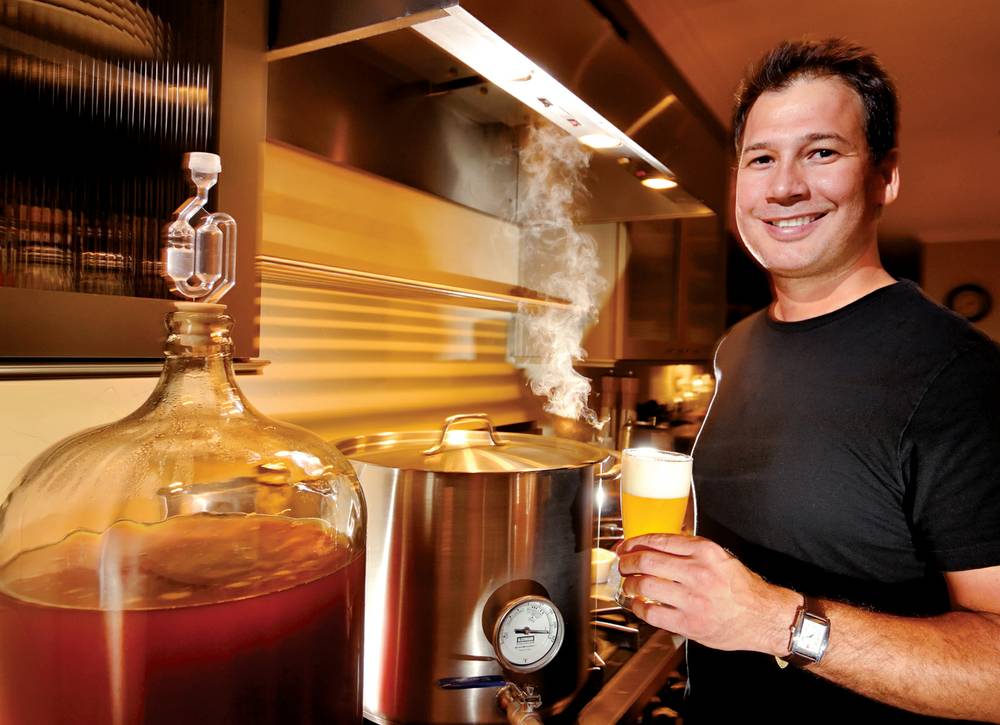“I’m going to start you off with some pale ale,” Eric Villareal tells me as I perch on a stool at his counter. A cutting board, on which rests some sourdough and a variety of cheeses, is within my reach. He pulls out a bottle without a label, pops the top and quickly pours it into a pilsner glass. I take a quick sip—mmmmm nice body, lots of carbonation and a nice, crisp taste. I’m enjoying it so much I don’t even need the bread and cheese.
Beer Issue!
But I have to take it easy. There’s a lot more to come from Villareal, one of Nevada’s many home brewers, those who love beer and all its intricate facets and want to re-create that experience using their own creativity and instincts. Villareal started brewing his own beer two years ago, and already he’s making a name for himself, garnering high marks in the annual Samuel Adams LongShot competition (two of his beers, both entered in the category of “specialty beers,” received marks of “very good,” above which are only “excellent” and “outstanding.”)
As Villareal heads to the fridge for the next round, I enviously check out a large carboy of Christmas ale brewing on his kitchen counter. Not yet, he says. It’s going to take a few more months. Damn! The next bottle is bigger, and this time has a label, “Summer Saison.” It’s a Belgian beer. His absolute favorite beer to brew. This is even more distinctive than the one before it—the flavors I detect are lemon zest and paradise seeds, he explains.
As much enjoyment as Villareal derives from his beers, he gets even more joy in explaining the various processes that go into his products. Everything being served tonight is achieved through the most basic of equipment—an 8-gallon boiling pot, a wort chiller (a large, copper coil that gets the mash down to the correct temperature so that the yeast can survive) and a few beakers and measuring cups, in all about $100 worth of equipment. Other than the barley, yeast, hops and water, everything else is just a matter of what type of beer you want to make, he explains. “Anyone can do this,” he says. “They’re just intimidated. It’s a matter of being interested in it.”
And Villareal, an engineer who makes batteries at K2 Energy, has been interested in beer long before he decided to begin brewing. “I grew up with Bud Lite, graduated to Sam Adams and Shiner Bock.” But six years ago he had his first Belgian beer at a Thai restaurant in San Francisco. “That really opened things up for me,” he says. His tastes now run more to Dogfish Head and Deschutes, but he’s particularly partial to New Belgium and its extensive line of beers, especially the Trippel and Ranger IPA. It’s those types of beers he most seeks to replicate at home.
Now we’re up to the next bottle, this one with a label reading “Belgian Trippel.” It has quite a kick, owing no doubt to its nearly 9 percent alcohol content. Villareal smiles, indicating he prefers to find out the alcohol content later in the process. He has an instrument that measures alcohol content, but he never uses it. “I would say I’m an adventurous brewer. I don’t follow the rule about checking chemistry and gravity.” An interesting take from a man who uses science for a living, but Villareal says home brewing is about following your gut, not some guidebook. “Most beer geeks I know don’t know anything about chemistry.” He equates it with cooking—the great cooks never look at a cookbook. “You just develop the innate ability to create something.”
It’s hard not to share Villareal’s passion for beer as he discusses “floculation,” “cold-filtering” and the process by which yeast eats sugar, giving off carbon dioxide and alcohol. Yes, he’s an analytical man at heart, but this hobby has given his creative side free rein. He’s put coffee, ginger, orange peel, coriander and more in his beers. “You can put cucumber into a beer.” It’s just fun, he explains. “It’s not like wine. Beer is less intimidating, more casual.” So casual, in fact, that he’s prone to mistakes. “But that’s what’s great about this. You can screw up, and it can still turn out great. I forgot to add hops one time, but it was fantastic. Sometimes not—I forgot to add sugar one time. Still very drinkable.”
A great byproduct of his hobby is being able to share it with friends and family, particularly in pairing it with meals. “Like, I’ll serve a steak with porter or a strong brown ale. Belgians go with anything. I’m also discovering how great pizzas are with beer. My current favorite is a goat cheese pizza with sun-ripe tomatoes. And the Texas in me pulls out the barbecue chicken pizza with a nice IPA.”
He’s been able to share some of his knowledge with the local home brewers’ club, the Southern Nevada Ale Fermenters Union (SNAFU), which meets at Freakin’ Frog the second Friday of each month. “There’s nothing like getting together with other people who share your passion, going, ‘Here dude, try this!’ And let me tell you, there are a lot better brewers in town than me.”
Before I head off, Villareal gets a sly smile on his face. “Want to try the first beer I ever brewed?” He brings out what I soon discover is the last bottle. He’s kept it for years, been saving it for a special occasion. Unfortunately, it’s been chilled a little too well and has iced up to the point where it’s barely trickling out of the bottle. Still, after each taking a sip, Villareal and I look at each other. I understand the reason for the sly smile—this is amazing stuff, with a hint of caramel and a smooth finish that lingers long afterwards. Villareal was onto something right from the beginning. We each decide to finish the bottle. Ice or no ice, we patiently wait for every last drop.


Previous Discussion: